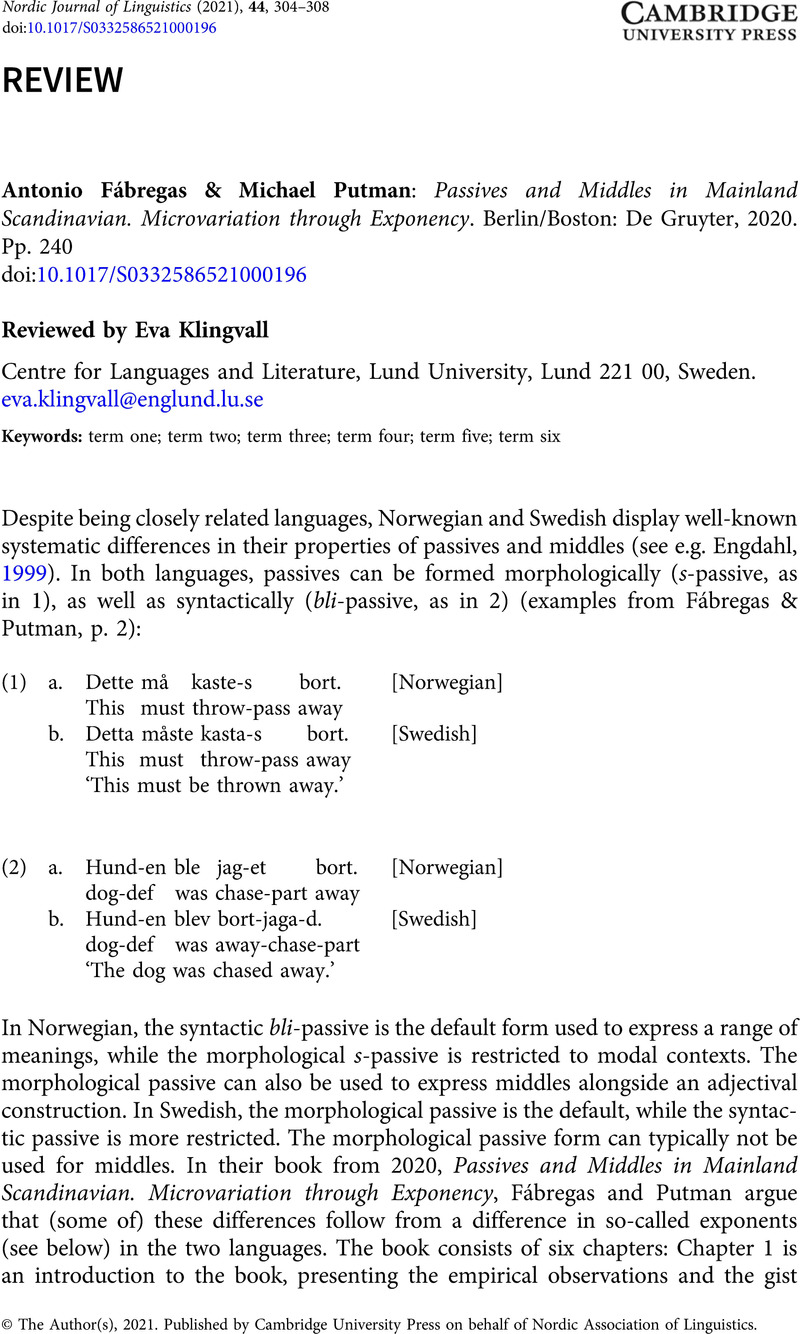No CrossRef data available.
Article contents
Antonio Fábregas & Michael Putman : Passives and Middles in Mainland Scandinavian. Microvariation through Exponency. Berlin/Boston: De Gruyter, 2020. Pp. 240.
Review products
Antonio Fábregas & Michael Putman : Passives and Middles in Mainland Scandinavian. Microvariation through Exponency. Berlin/Boston: De Gruyter, 2020. Pp. 240.
Published online by Cambridge University Press: 07 September 2021
Abstract
An abstract is not available for this content so a preview has been provided. Please use the Get access link above for information on how to access this content.

- Type
- Book Review
- Information
- Copyright
- © The Author(s), 2021. Published by Cambridge University Press on behalf of Nordic Association of Linguistics
References
Engdahl, Elisabet. 1999. The choice between bli-passive and s-passive in Danish, Norwegian and Swedish. NORDSEM report 3.Google Scholar
Fábregas, Antonio & Putman, Michael. 2020. Passives and Middles in Mainland Scandinavian. Microvariation through Exponency. Berlin/Boston: De Gruyter.10.1515/9783110670912CrossRefGoogle Scholar
Halle, Morris & Marantz, Alec. 1993. Distributed morphology and the pieces of inflection. In Hale, K. & Keyser, S.J. (eds.) The View from Building 20, 111–176. Cambridge, MA: MIT Press.Google Scholar
Halliday, Michael A.K. 1967. Notes on transitivity and theme in English. Part 2. Journal of linguistics 3, 199–244.10.1017/S0022226700016613CrossRefGoogle Scholar
Hedlund, Cecilia. 1992. On participles. PhD dissertation, Dept Linguistics, Stockholm University.Google Scholar
Julien, Marit. 2007. On the relation between morphology and syntax. In Ramchand, G. & Reiss, C. (eds.) The Oxford Handbook of Linguistic Interfaces, 209–238. Oxford: Oxford University Press.Google Scholar
Klingvall, Eva. 2012. Complex non-compound words in Swedish. Studia linguistica 66: 1–31.10.1111/j.1467-9582.2012.01188.xCrossRefGoogle Scholar
Klingvall, Eva. 2007. (De)composing the middle. A minimalist approach to middles in English and Swedish. PhD dissertation, Lund University.Google Scholar
Laanemets, Anu. 2012.
Passiv i moderne dans, norsk of svensk. Et korpusbaseret studie af tale- og skriftsprog
. Dissertationes Philologicae Scandinavicae Universitatis Tartuensis 2. Tartu: University of Tartu Press.Google Scholar
Lekakou, Marika. 2005. In the middle, somewhat elevated. The semantics of middles and its crosslinguistic realization. PhD dissertation, UCL, University of London.Google Scholar
Talmy, Leonard. 1985. Lexicalization patterns: semantic structure in lexical forms. In Shopen, T. (ed.) Language typology and syntactic description. vol. III: Grammatical categories and the lexicon, 57–149. Cambridge: Cambridge University Press.Google Scholar
Teleman, Ulf, Staffan, Hellberg & Erik, Andersson. 1994. Svenska Akademiens Grammatik. Stockholm: Norstedts.Google Scholar





